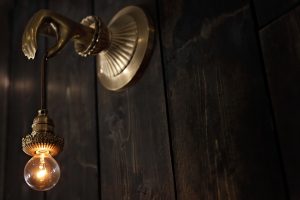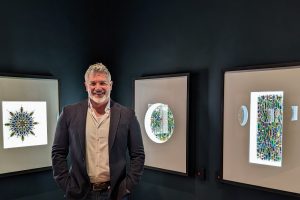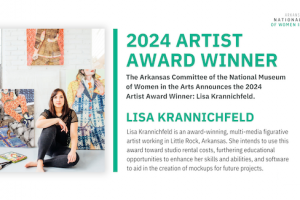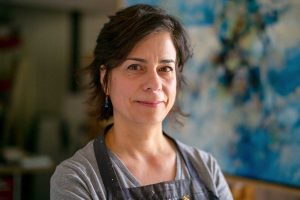MY SOAPBOX AT THE DOLLAR SAVER

WORDS / DYLAN TURK
PHOTOS / MEREDITH MASHBURN
I grew up in Little Rock. It’s not perfect—far from it—but there is a deep history of preservation there. There is a pride for the buildings that tell our history. There is an understanding that the marks of our civilization are in the built-environment. Since moving to Northwest Arkansas in 2010, I’ve been shocked by the lack of preservation—the lack of understanding around how, when, and why a building should stay, be altered, or go away.
Design is everywhere. It is often misunderstood or incorrectly implemented, but it is always there. To me, it is the way we experience our surroundings—how spaces make us feel.
I believe that the best design balances a unique collision of where we were and where we want to go. It is art. A visual story of who we are, where we came from, and how we see ourselves. There are no rules in art…there can’t be. I can’t give you a rule book about preservation, because each case is totally different. I can tell you to follow your gut. I can tell you to save the millwork if its original. I can tell you that it is ok to shift the program of a historic building—in fact, I recommend it. I can tell you that is is an essential function of our city governments to preserve and protect our buildings, and to guide investment and growth in a way that leans into what we already have rather than totally rewrite our architectural story.
As communities grow, industries shift, and society evolves our job is to hold onto what is important and push the rest forward. Our communities need space—space for new business, for creatives to create, for people to know they belong. The things that happen in those spaces help make us unique and drive us towards a more accepting and beautiful city. The things that happen in those spaces move us forward.
I’m reminded of the fabulous Gay Oil Building on the corner of 3rd and Broadway in Little Rock. A building I’ve seen my entire life. Every time I find myself at that stoplight I dream of how that space could change someone’s life—become something that shifts someone’s world. A couple of months ago, someone reported that an application to change this glass-lined beauty into a carwash was submitted to the city. The community immediately responded with calls to halt the application, because that building deserves more reverence. History is power. Stories are power. The Mayor got involved. I don’t know the building’s fate.
A common misunderstanding about historic preservation is that a building should look and feel like it did when it was originally built. That isn’t the whole story. Preservation is really about keeping and celebrating essential elements of a past architectural moment—what makes the building uniquely of a specific time—while creating something beautiful and functional in the present. Yes, it is scary to tackle a building that is 100 years old, but it is our duty as a society to evolve our built-environment. Don’t destroy it. Protect it. Make it a part of us.
Spaces have always interested me. I’m lucky because I spend a lot of time in truly great spaces. My first major project in my professional life was curating Frank Lloyd Wright’s Bachman-Wilson House at Crystal Bridges Museum of American Art. The guiding force on that project was to save the building and share the power of beauty in design. A private home shifted to a museum object—a monument to architecture and design. Our goals were to educate people on the power of a space and encourage others to consider the spaces they currently live in or have the power to change.
Four years after that first project opened, I found myself in the 1907 Building in Rogers being moved by the space I was in. My family loves tacos and margaritas. My mom Christie, my Cousin Coker, my cousin-in-law Clair and I try to get together every week. We vent about our work, talk about our family, laugh about the world and let go of our worries. It’s my favorite day of the week, because we aren’t pretending to by anything we aren’t. We aren’t trying to prove anything to each other. We are ourselves—honest and true.
My mom received an invite to the soft opening of Yeyo’s new space in Rogers, so we pushed out of our regular place to try something new. I’d been to Rogers before, but tonight was different. The 1907 Building—at night—transported us. We sat next to the kitchen. The room smelled like burning piñon and sage. The walls, gradient from dark blue to light grey, begged for my hands to run across the textured concrete. The space is so intimate. A bar, small dining space and then a larger dining loft compose the entire Yeyo’s concept.
When I find myself in a space that is well designed, I get this flutter inside. I can’t describe what happens—but I know that the space is persuading me to see something, say something, feel something.
Halfway through that magic dinner, Chef and Owner Rafael Rios stood in front of the gorgeous bar and quieted the room. He smiled, proudly looked through the room, and thanked all of those that had made that moment—and everything that led him there—possible. He said that when thinking about how they were going to tell the story of their food—their story—the space needed to help guide us. The light, texture, layers of materials, ceremony of space, spiritually and iconography in the room had to be of their home in Mexico. He said that the gradient walls, the handmade masks by artist Octavio Logo, the dappled light and the modern millwork were all tools to take us on a journey with their food.
The room was alive. Honest and beautiful. After consuming too much food and just enough Mezcal, we gracefully stumbled upstairs to the Foreman. The Foreman is a bar in the back rafters of the 1907 Building. Hugging the black marble bar, singular puddles of light fall below my sight lines—only illuminating my drink. Dramatic white veins crack through the black marble slabs that dominate the bar wall. As my eyes adjust, the leather cocktail room reveals itself. Fully embracing the form of the skylight above, stuffed diamond-stitch black leather covers every vertical surface. The room is filled with people.
I could have sat at that bar all night. It reminded me of Manhattan. It was more than I hoped it could be. The next day I went back, and the building was totally different in daylight. Onyx took center stage. It was packed and the design—the preservation—was clear.
The facade, deep red Midwestern brick, unchanged from 1907, reminds us of a moment in architecture when even a grocery store required elements of beauty. The interior is defined by juxtaposition. The plaster and drywall has been removed throughout, revealing the brick understructure. A classic element of Modernism is to let the building speak for itself. This 100-year-old building became Modern in some ways because it reveals how it stands—the function and engineering become the ornamentation—the beauty. The brick isn’t smooth, or perfect. It hasn’t been sealed or painted. It is simple and honest. If you stare at the walls, the scars start to tell you what happened here—the patina, like wrinkles on a face show the beauty of the passage of time.

The exposed ceiling beams and rafters are my favorite element. They are visible through every space. The rhythm created by them carries you. They suggest a procession and a pace to move in the space. They’ve juxtaposed all of these patterns and layers with clean, luscious materials like marble, concrete, wood and glass. It is balance. The space says “this is who I was and this is where we are going.” To me that is the perfection of preservation—making a space for who we are in the remains of who we were.
One of the best ways to bring a space back is to bring creation back into it. Fill the space with energy. Now, rather than a space that sells regular goods, this space showcases the alignment of creativity and ambitious business. Every occupant of the 1907 Building has something to say. Their passion, ideas and hard work brought them here. Maybe someone in this room had an idea about what is next—maybe this place gave them the space to turn their ideas into something real.
Smart, creative preservation like the 1907 Building helps us tell our history, gives communities space to create, and considers our environmental impact. In the words of noted architect Carl Elefante, “the greenest building is the one that is already built.” Our responsibility is to develop our communities conscientiously: not to be scared of the scars, but to embrace everything that carried us to this moment of boundless promise. I can stand on my soapbox all day, preaching the gospel of sustainability, preservation and the power of great design. At night, if you’re looking for me, I’ll be in The Foreman admiring the marble and dreaming of something in the bottom of a glass.
A condensed version of this story appears in the print magazine.




Comments